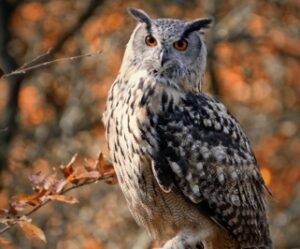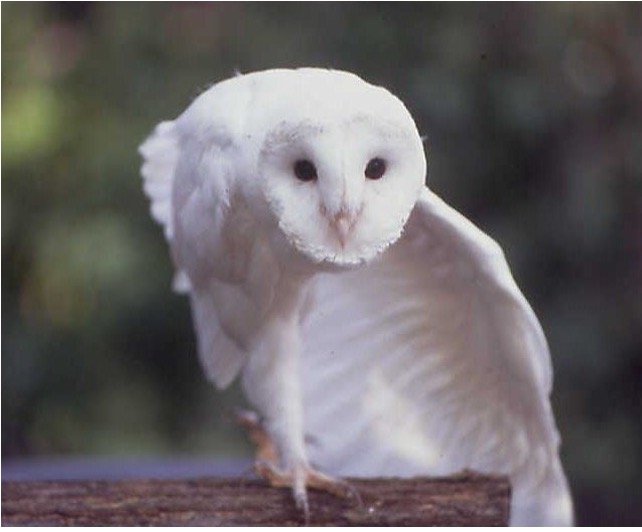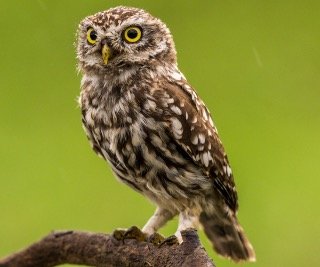
Why Do Owls Hoot?
Owls are well-known for their hooting behavior. These birds, on the other hand, do not hoot very frequently. Most of the time, these birds are deafeningly quiet. You may live next to a forest full of owls and never hear a single hoot from any of them.
15 Cutest Owls In The World
Although owls are usually silent, there are a few occasions when they will break their typical silence and hoot.
Listen Owls Hoot (Western Barn Owl – Tyto alba)
Credit: Manceau Lionel, XC659876. Accessible at www.xeno-canto.org/659876
Why Do Owls Hoot?
The top four reasons why owls hoot are as follows:
1. To Mark Their Territorial Claim
Primarily, owls screech to assert their territory and scare away intruders from their region. Similar to how wolves mark their territory by howling, this is a form of territorial marking. The majority of owls have some sense of their own region.

They will make every effort to keep their hunting territory safe from any intruders. In order to communicate with others, owls hoot in order to communicate where they are, which is normally within their area. Other owls will be able to easily avoid them as a result of this announcement, minimizing the likelihood of a battle.
Do Owls Hoot During the Day? All You Need To Know
2. To Alert The presence Of Predators
Owls may also yell at predators if they feel threatened. We’re baffled as to why they do this. It’s possible that they’re warning other owls or that they’re simply surprised by the predator. After hooting at a predator, a large number of owls will flee the area. While some will leave, others will remain and yell at them on a constant basis.
Listen Owls Hoot (Eastern Barn Owl – Tyto javanica)
Credit: Lim Ying Hien, XC613726. Accessible at www.xeno-canto.org/613726
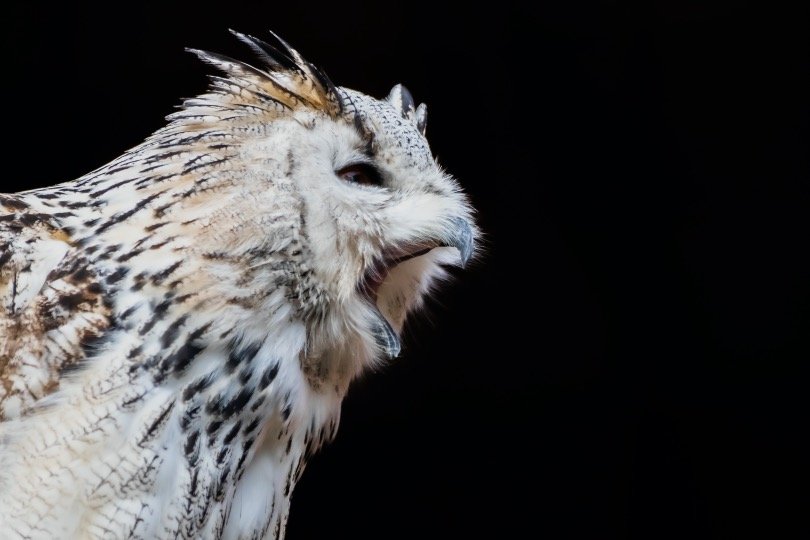
3. To Mate
When owls are mating, the majority of them hoot. Because owls are known to mate for life in the majority of situations, they will communicate with one another through hoots. Numerous couples will also “sing” together in order to confirm their relationship and promote togetherness. As a result, if you hear two owls singing together, it is likely that they are going to mate.
6 Reasons – Why Do Owls Bob Their Heads?
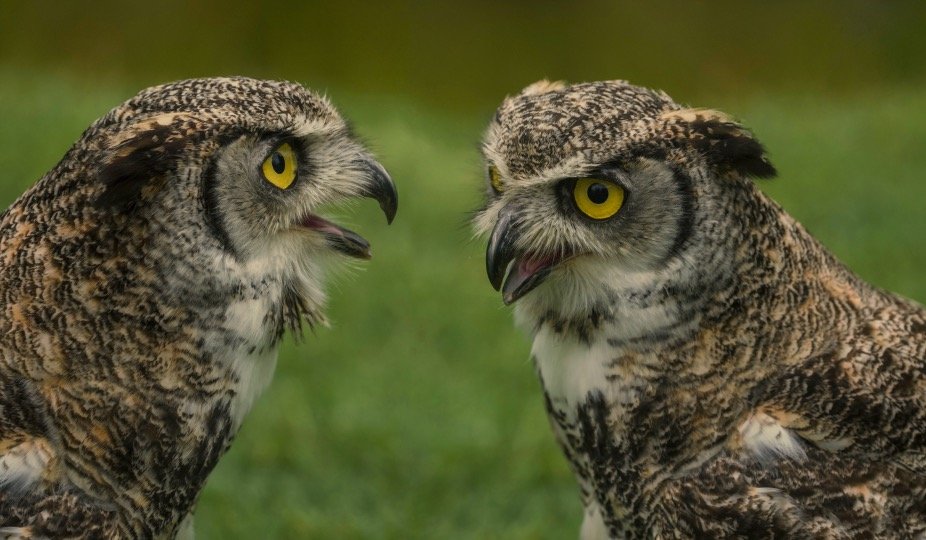
4. To Interact With Other Owls
Unless they are mates, owls generally do not converse with one another directly in their natural environment. Owls, on the other hand, can distinguish between individuals based on their hoots. Aggressive owls attack strangers who approach their territory.
Listen Owls Hoot (Eurasian Eagle-Owl – Bubo bubo)
Credit: Stanislas Wroza, XC702386. Accessible at www.xeno-canto.org/702386
However, if the owls are familiar with one another, they will be less hostile. Because of this, owls may hoot to alert other owls that they are not strangers, hence lessening their aggressive behavior toward them.

Because owls are able to maintain consistency in their vocalizations throughout time, other owls can recognize them even after many years of separation. We don’t know how long owls retain their memories of other people’s vocalizations, but it’s possible that they do so for their entire lifetimes. Therefore, even after being separated, siblings and parents may be able to recognize one another.
How Do Owls Hoot?
1. Eurasian Eagle-Owl Song Hoot
Credit: Bram Vogels, XC650599. Accessible at www.xeno-canto.org/650599
2. Eurasian Eagle-Owl Begging Hoot
Credit: Baltasar Pinheiro, XC656744. Accessible at www.xeno-canto.org/656744
How To Interpret Owl Hoots?
Because owls only hoot for a limited number of reasons, it is typically simple to distinguish between their hoots. For example, the sound of a territorial hoot differs from the sound of a mating call. Having said that, the majority of owls can make at least 13 different noises.

These will be used in a consistent manner in a variety of situations. It is therefore possible to tell what an owl is talking about with just a little basic knowledge.
For example, hostile hoots may be made by two males who are challenging each other or one who is letting the other know that they are not pleased with their presence. It could also be considered territorial noises. Typically, these hoots are louder and last for a longer period of time.
Sleeping Owls Are So Adorable: Pictures & Fun Fact
Hoots produced by mating pairs are substantially more subdued. They are often composed of a sequence of hooting sounds made by two different owls and occur between them. Females will frequently hoot first, with the male responding to her hoots in turn.
This type of vocalization is typically heard more frequently around the end of the breeding season. Occasionally, females will begin the duet after the male brings her food, which is a common aspect of the mating ritual for many species.
When meeting a new owl, an owl may produce a crow-like noise to signal their presence. This is frequently referred to as a “greeting,” and the owl uses it to figure out who the other owl is. The owls will treat strangers with greater care than they will treat friendly ones.
When Do Owls Make Their Hoots?
If you’re interested in hearing an owl hoot, you can dramatically increase your chances of hearing their vocalizations by following these steps. Owls begin to hoot even before they are born into the world. Owls will hoot softly when they are in their eggs.
After hatching, the newborn owls will produce short chirps in order to communicate with their mother. When the mother is close by with food, the number of calls will rise. All of these hoots, however, are difficult to hear by the typical person since owls prefer to nest in areas where they are not disturbed by humans.
What Eats Owls? 7 Predators That Eat Owls
In most cases, the best time to hear owls is during their mating season (March through May). This type of hoot will be produced by males during their first mating season.
It will, however, take some time before they are able to perform these hoots accurately. As a result, they may appear a little strange at first.

Owls are known to hoot the most soon after the sun sets on the horizon. They will, however, continue to hoot throughout the night if necessary, according to the situation. Predicting the owl’s behavior is challenging because it is dependent on the owl’s specific situation.
Due to the fact that these owls are nocturnal, you are unlikely to hear them during the day. On cloudy days, though, they may be heard early in the morning, especially at night. Many species of owl will hoot their heads off during the new moon, when the sky is darker.
Can Owls Rotate Their Heads? All You Need To Know
Other species, on the other hand, hoot more when the weather is sunny. It might vary from owl to owl, and it can also fluctuate according on the time of year.
Owls Hoot vs Mourning Doves
Mourning Doves have a sound that is comparable to that of owls. They do, however, make the majority of their calls during the day. It’s likely that you’re hearing the hooting of a mourning dove during the daytime hours.

This species has a predetermined hooting sequence that it follows. It sounds a little like “Hooooo, hoo, hoo, hoo, hoo, hoo, hoo, hoo.” The call of the owl will vary depending on the situation.
Listen Mourning Doves Hoot (Mourning Collared Dove – Streptopelia decipiens)
Credit: Peter Boesman, XC510411. Accessible at www.xeno-canto.org/510411
Additionally, as the series progresses, mourning doves become more and more silent, but this is not always the case with owls. Listen to a few videos of doves hooting and you’ll be able to discern the difference between them and owls in no time.
Why Do Owls Hoot 3 Times or 4 Times?
There is no specific reason why owls hoot three times or four times, as the number of hoots can vary depending on the species of owl and the situation. Some species of owls may hoot once, twice, thrice or more than four times in a row.
Why Do Owls Hoot At Night?
Owls are nocturnal animals, which means they are mostly active at night. During their active hours, they communicate with other owls by hooting. Many owl species hunt for prey at night, so hooting can assist them in locating potential food sources.
Some owl species use hooting to mark their territory and warn other owls to stay away. They may also hoot in order to attract a mate or to communicate with their mate or offspring.
Hooting is also a natural behavior for owls that allows them to express themselves. They may hoot simply to express themselves, similar to how humans may talk or sing for enjoyment or to express themselves.
Why Do Owls Hoot During Day?
Owls are primarily nocturnal creatures, which means they are most active at night. Owls may hoot during the day for the same reasons they do at night, such as communicating with other owls, establishing territory, or attracting a mate.
Some owl species, however, may be active during the day, especially during breeding season or when they have young to care for. In addition, some owl species may hunt during the day if they are hungry or if their preferred prey is more active during the day.
Hooting can assist them in locating potential food sources, just as it can assist them in locating prey at night.

Why Do Owls Hoot in the Morning?
Owls are mostly active at night, but they may hoot in the morning for various reasons.
1. Possible explanation is that they have finished their nighttime activities and are returning to their roosting location to rest for the day. They may hoot to communicate with other owls or to establish their territory as they settle down.
2. Another reason for early morning hooting could be breeding. Male owls may hoot to attract a mate even in the early morning hours during breeding season. Female owls may also hoot to communicate with their mate or offspring.
3. Some owl species are crepuscular, which means they are most active during the dawn and dusk hours. These owls may hoot in the morning as they start their day and prepare to hunt for prey.
Why Do Owls Hoot in the Fall?
Owls may hoot in the fall for a variety of reasons, including breeding, territory, and migration.
1. Many owl species have their breeding season in the winter or early spring, so hooting in the fall could be related to establishing territorial boundaries and attracting a mate. Male owls may hoot to announce their presence and defend their territory from competing males, whereas females may hoot in response to indicate their interest in mating.
2. Owls may hoot as they prepare to migrate in the fall. During the winter, some owl species migrate to different areas, and hooting can help them communicate with other owls as they travel through unfamiliar territory. Hooting can also assist owls in locating other owls for socialization or mating purposes as they travel.
3. Hooting in the fall may simply be a part of an owl’s daily routine, as vocalizations are used to communicate with other owls, establish territories, and hunt for prey. Hooting can be heard more clearly in the fall because of cooler weather and less foliage on the trees, making it easier for owls to find and communicate with one another.
Why Do Owls Hoot in the Winter?
Owls may hoot in the winter for a variety of reasons, including breeding, territory, and survival. Many owl species have their breeding season in the winter or early spring, so hooting in the winter could be related to establishing territorial boundaries and attracting a mate.
Male owls may hoot to announce their presence and defend their territory from competing males, whereas females may hoot in response to indicate their interest in mating. Owls may hoot in the winter as they search for food and hunt for prey, in addition to breeding.
Many animals face difficulties during the winter, and hooting can help owls locate prey and communicate with other owls, increasing their chances of survival.
Winter hooting may also be associated with communication and socialization. Owls are social animals that use hooting to communicate with other owls in their vicinity, form social bonds, and coordinate their activities.
Why Do Owls Hoot at Each Other?
Owls communicate by hooting at each other, which can serve a variety of purposes depending on the situation. One of the most common reasons owls hoot is to mark their territory and communicate with other owls in the area. An owl can let other owls know where its territory begins and warn them to stay away by hooting.
During the breeding season, owls may also hoot to attract a mate. Male owls frequently hoot to signal to females that they want to mate and to establish their territory. Females may also hoot in response, indicating their desire to mate.
Owls may hoot to communicate with their mate or offspring in addition to territorial and breeding behaviors. A female owl, for example, may hoot to alert her mate that she requires assistance with incubating the eggs or caring for the young.
Why Do Great Horned Owls Hoot?
Great Horned Owls hoot for a variety of reasons, including communication, breeding, and territory. The following are some of the primary reasons why Great Horned Owls hoot:
1. Communication: Hooting is used by Great Horned Owls to communicate with other owls in their territory. Hooting can alert other owls to their presence, and it can also be used to locate other owls and form social bonds.
2. Breeding: Male Great Horned Owls will hoot to attract a mate and defend their territory against other males during the winter. Females may also hoot in response to indicate their desire to mate.
3. Territory: Great Horned Owls are territorial birds that will hoot to establish and defend their territory. Hooting can also be used to warn other owls to stay away.
4. Hunting: Great Horned Owls are expert hunters who use hooting to locate prey. They may hoot in order to communicate with other owls and plan their hunting activities.
Take Away Message
An owl’s principal mode of communication is by hooting. However, because they are solitary animals, they do not make a great deal of noise. When you hear an owl hoot, it’s likely that you’ll be out late into the night.
Owls are most active in the night hours following sunset and during the breeding season. Some individuals may alter their degree of activity based on the time of the month.
